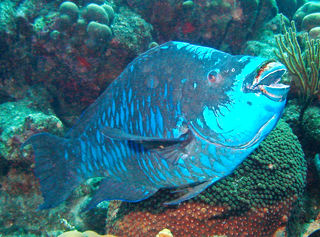
Parrotfish are a group of fish species traditionally regarded as a family (Scaridae), but now often treated as a subfamily (Scarinae) or tribe (Scarini) of the wrasses (Labridae). With roughly 95 species, this group's largest species richness is in the Indo-Pacific. They are found in coral reefs, rocky coasts, and seagrass beds, and can play a significant role in bioerosion.

The green humphead parrotfish is the largest species of parrotfish, growing to lengths of 1.5 m (4.9 ft) and weighing up to 75 kg (165 lb).

Sparisoma is a genus of parrotfishes native to warmer parts of the Atlantic. FishBase recognizes 15 species in this genus, including S. rocha described from Trindade Island in 2010 and S. choati described from the East Atlantic in 2012. They are the most important grazers of algae in the Caribbean Sea, especially since sea urchins, especially Diadema, the other prominent consumers of algae, have been reduced in many places by a recent epidemic.

The marbled parrotfish, also known as the seagrass parrotfish, is a species of parrotfish, the only known member of the genus Leptoscarus. It has a wide Indo-Pacific distribution and is also found in the southeastern Atlantic Ocean. It is a coastal species found in beds of sea grass and seaweed.

The midnight parrotfish is a species of parrotfish that inhabits coral reefs mainly in the Caribbean, Bahamas, and Florida.

The stoplight parrotfish is a species of marine ray-finned fish, a parrotfish from the family Scaridae, inhabiting coral reefs in Florida, Caribbean Sea, Gulf of Mexico, Bermuda and as far south as Brazil. It mainly feeds on algae by scraping and excavating it with its teeth. Like most of its relatives, it is able to change sex.

The Mediterranean parrotfish is a species of parrotfish found at depths up to 50 m (160 ft) along rocky shores in the Mediterranean and the eastern Atlantic, from Portugal south to Senegal. It is generally common, but uncommon or rare in the northwestern Mediterranean and in the Adriatic Sea. It prefers relatively warm temperatures and there is an ongoing northward range expansion, possibly due to global warming. The primary adult habitat is rocky reefs, especially in areas with macroalgae, but they may visit adjacent seagrass patches. Juveniles also occur more widely in the latter habitat.

The queen parrotfish is a species of marine ray-finned fish, a parrotfish, in the family Scaridae. It is found on reefs in the tropical West Atlantic Ocean and the Caribbean Sea. Other common names include blownose, blue chub, blue parrotfish, blueman, joblin crow parrot, moontail, okra peji and slimy head. The young males and adult female queen parrotfish are a reddish-brown color, and quite different in appearance from the bluish-green color of the final phase male. This is a common species throughout its range and the International Union for Conservation of Nature has rated its conservation status as "least concern".
Sparisoma tuiupiranga is a species of marine ray-finned fish, a parrotfish from the family Scaridae. It has a single midventral scale posterior to the insertion of the pelvic fins. Its distribution extends from 18°S to 27°S in the western Atlantic, off the coast of Brazil. This species is found in shallow areas of tropical rocky reefs. The males establish territories of approximately eight square metres. The juveniles have a strong association with seaweed beds where they occasionally mix with Sparisoma radians and Cryptotomus roseus. It grazes on a wide variety of algae growing on rocks and so ingests a large amount of sediment. It can be adaptable in its feeding habits and is frequently seen feeding over Sargassum.

Sparisoma chrysopterum is a species of parrotfish.

Sparisoma aurofrenatum is a species of parrotfish native to the Caribbean Sea and Western Atlantic Ocean.

Scarus scaber, the five-saddle parrotfish or dusky-capped parrotfish, is a species of marine ray-finned fish, a parrotfish, in the family Scaridae. It is native to Indian Ocean.

Calotomus zonarchus, commonly known as yellowbar parrotfish, is a species of parrotfish native to the waters of the Hawaiian Islands.

Scarus globiceps, commonly known as the globehead, violet-lined, speckled or roundhead parrotfish, is a marine fish native to the Indian and Pacific Oceans, where it lives in coral reefs.
The João Lopes Bank is a seamount situated 1 nautical mile (1.9 km) northwest of the community of Anjos, on the Portuguese island of Santa Maria in the Azores.

Taganga is a traditional fishing village and corregimiento of Santa Marta, located on the Caribbean coast of Colombia at about 10 minutes or 3 kilometres (1.9 mi) north of Santa Marta. Both Santa Marta and Taganga were founded by Rodrigo de Bastidas on July 29, 1525, making them two of the oldest remaining colonial settlements in present-day Colombia.

Scarus fuscopurpureus, common name purple-brown parrotfish, is a species of marine ray-finned fish, belonging to the class Actinopterygii. It is a parrotfish in the family Scaridae. It occurs in the western Indian Ocean, the Red Sea, the gulf of Aden and the Persian Gulf. Countries in which boarder these waters include, but are not limited to Egypt, Sudan, Saudi Arabia, Yemen, Kuwait, and the United Arab Emirates.

The Fradinhos is an unvegetated, uninhabited islet group composed of four distinct escarpments located off the southeast coast of the island of Terceira in the Portuguese archipelago of the Azores.

Sparisoma rocha or Trindade parrotfish is a species of parrotfish endemic to the islands of Trindade and Martin Vaz in southeastern Brazil. The species can be distinguished from its congeners easily by its coloration. S. rocha is a herbivore, grazing on algae that grows on rocks or coralline substrate.

Sparisoma rubripinne, which also goes by the common names yellowtail parrotfish or redfin parrotfish is a species of parrotfish in the genus Sparisoma. It can be found in the Western Atlantic Ocean, and is primarily found in the Caribbean Sea.


















